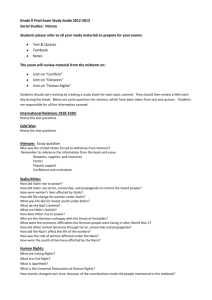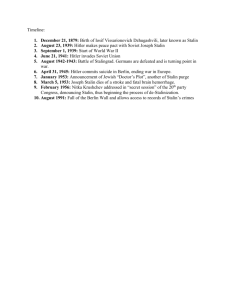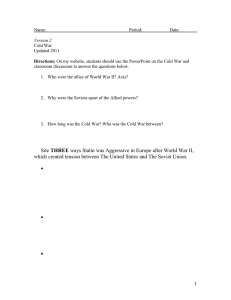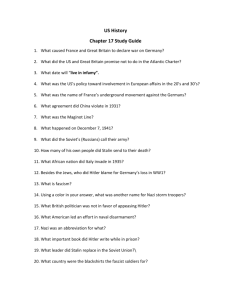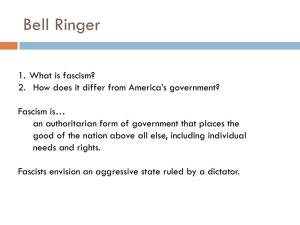DBQ Discussion:: Hitler vs. Stalin?
advertisement
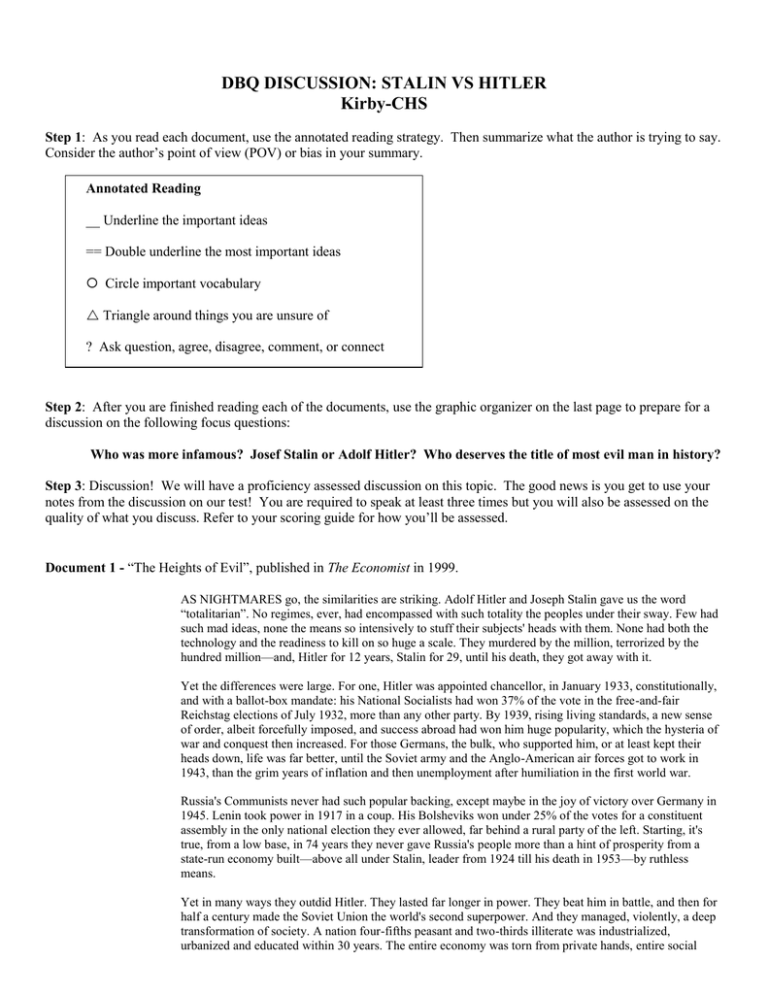
DBQ DISCUSSION: STALIN VS HITLER Kirby-CHS Step 1: As you read each document, use the annotated reading strategy. Then summarize what the author is trying to say. Consider the author’s point of view (POV) or bias in your summary. Annotated Reading __ Underline the important ideas == Double underline the most important ideas Circle important vocabulary Triangle around things you are unsure of ? Ask question, agree, disagree, comment, or connect Step 2: After you are finished reading each of the documents, use the graphic organizer on the last page to prepare for a discussion on the following focus questions: Who was more infamous? Josef Stalin or Adolf Hitler? Who deserves the title of most evil man in history? Step 3: Discussion! We will have a proficiency assessed discussion on this topic. The good news is you get to use your notes from the discussion on our test! You are required to speak at least three times but you will also be assessed on the quality of what you discuss. Refer to your scoring guide for how you’ll be assessed. Document 1 - “The Heights of Evil”, published in The Economist in 1999. AS NIGHTMARES go, the similarities are striking. Adolf Hitler and Joseph Stalin gave us the word “totalitarian”. No regimes, ever, had encompassed with such totality the peoples under their sway. Few had such mad ideas, none the means so intensively to stuff their subjects' heads with them. None had both the technology and the readiness to kill on so huge a scale. They murdered by the million, terrorized by the hundred million—and, Hitler for 12 years, Stalin for 29, until his death, they got away with it. Yet the differences were large. For one, Hitler was appointed chancellor, in January 1933, constitutionally, and with a ballot-box mandate: his National Socialists had won 37% of the vote in the free-and-fair Reichstag elections of July 1932, more than any other party. By 1939, rising living standards, a new sense of order, albeit forcefully imposed, and success abroad had won him huge popularity, which the hysteria of war and conquest then increased. For those Germans, the bulk, who supported him, or at least kept their heads down, life was far better, until the Soviet army and the Anglo-American air forces got to work in 1943, than the grim years of inflation and then unemployment after humiliation in the first world war. Russia's Communists never had such popular backing, except maybe in the joy of victory over Germany in 1945. Lenin took power in 1917 in a coup. His Bolsheviks won under 25% of the votes for a constituent assembly in the only national election they ever allowed, far behind a rural party of the left. Starting, it's true, from a low base, in 74 years they never gave Russia's people more than a hint of prosperity from a state-run economy built—above all under Stalin, leader from 1924 till his death in 1953—by ruthless means. Yet in many ways they outdid Hitler. They lasted far longer in power. They beat him in battle, and then for half a century made the Soviet Union the world's second superpower. And they managed, violently, a deep transformation of society. A nation four-fifths peasant and two-thirds illiterate was industrialized, urbanized and educated within 30 years. The entire economy was torn from private hands, entire social classes demonized and destroyed. The once mighty Russian church became, on sufferance, a eunuch of the state. Hitler, charismatic and revolutionary by temperament, did none of this. He uprooted Germany's political establishment, but not the fundamentals of its economy or the social order. Nor were the two ideologies mirror images of each other. Communism offered a coherent belief system, based on a false theory of the perfectibility of man and the pseudo-science of economic determinism. It had universal appeal: brutal in fact, but seemingly idealistic, the system solidified under Stalin won admiration in many poor countries and from a host of clever fools in rich ones. Hitler's notions were woollier, more mystical, resting on such concepts as will, authority, racial superiority and worship of the leader. They spoke only to the German-speaking Reich, though he had emulators among those who upheld fascism (a different idea, though the two are often thought the same) in Italy and Spain. He successfully spoon-fed an educated nation vile anti-Jewish fantasies that should have been spat out by any ten-year-old. But only the besotted (which included neither Mussolini nor Franco) could take them seriously, except in their more than vile results. Although Stalin too used a cult of personality, his system survived him; it is unlikely that Hitler's could have. One thing the two had in common: ruthless violence. Both used ferocious internal repression. The edge here goes to Stalin. Even Hitler's armies of snoopers, his 95 Germans a day convicted of political crimes in 1933-39, his political murders, concentration camps and killings of Jews and left-wingers in that period, cannot match Stalin's record. Russia had traditions of secrecy and violence; but the isolation, paranoia and terror that kept the Soviet people in thrall for so long exceeded anything comparable, anywhere, ever. Both men also oversaw worse than that: mass murder. Hitler's massacre of European Jews was an act of genocide without millennial equal. It is a cruel irony that Germany's own half-million, attacked from 1933 on, had more chance of flight in 1933-39 than the millions in Nazi-occupied countries, once their fate had been decided on in 1942. Slavs, Gypsies and what the Nazis saw as other sub-species also were killed in millions. Add on the 40m-50m dead, direct and indirect, of the war that Hitler unleashed in 1939 and he must lead history's list of infamy. Unless Stalin does. He, even if not alone, must share the guilt of war; whatever the errors of Britain and France, it was his pact with Hitler in August 1939 that gave the green light. And the total of Stalin's victims in peace-time in his own country—no serious estimate is below 11m, some much higher—far exceeded those that Hitler had notched up by 1939. That many died of famine due to forced collectivization in Ukraine and elsewhere in 1928-33, in deportations of entire peoples later, or, at all times, in inhuman labor camps, rather than by overt execution, lessens his guilt not a jot. At his death in 1953, the labor camps had never been so full. The two countries and peoples have emerged very different from their past. Russia, like much of the eastern Europe that it misruled for nearly 45 years, is still mired in poverty, corrupt, barely democratic. Vanquished Germany, soon allied with its western conquerors, and rapidly rose from the ashes of totalitarianism to become a decent land of freedom and prosperity. And peace. There is no answer to the question which was more evil, Hitler or Stalin? Stalin's legacy, by the weight of time, has proved harder to offload. But both men defy moral measurement. It is like asking whether pulling out toenails or giving electric shocks to the genitals is the more acceptable form of torture. Document 2- “Hitler vs. Stalin: Who Was Worse?” by Timothy Snyder, writer of Bloodlands: Europe Between Hitler and Stalin. Published in 2012. As we recall the Red Army’s liberation of Auschwitz on January 27, 1945, sixty-six years ago today, we might ask: who was worse, Hitler or Stalin? In the second half of the twentieth century, Americans were taught to see both Nazi Germany and the Soviet Union as the greatest of evils. Hitler was worse, because his regime propagated the unprecedented horror of the Holocaust, the attempt to eradicate an entire people on racial grounds. Yet Stalin was also worse, because his regime killed far, far more people—tens of millions, it was often claimed—in the endless wastes of the Gulag. For decades, and even today, this confidence about the difference between the two regimes—quality versus quantity—has set the ground rules for the politics of memory. Even historians of the Holocaust generally take for granted that Stalin killed more people than Hitler, thus placing themselves under greater pressure to stress the special character of the Holocaust, since this is what made the Nazi regime worse than the Stalinist one. Discussion of numbers can blunt our sense of the horrific personal character of each killing and the irreducible tragedy of each death. As anyone who has lost a loved one knows, the difference between zero and one is an infinity. Though we have a harder time grasping this, the same is true for the difference between, say, 780,862 and 780,863—which happens to be the best estimate of the number of people murdered at Treblinka. Large numbers matter because they are an accumulation of small numbers: that is, precious individual lives. Today, after two decades of access to Eastern European archives, and thanks to the work of German, Russian, Israeli, and other scholars, we can resolve the question of numbers. The total number of noncombatants killed by the Germans—about 11 million—is roughly what we had thought. The total number of civilians killed by the Soviets, however, is considerably less than we had believed. We know now that the Germans killed more people than the Soviets did. That said, the issue of quality is more complex than was once thought. Mass murder in the Soviet Union sometimes involved motivations, especially national and ethnic ones, that can be disconcertingly close to Nazi motivations. It turns out that, with the exception of the war years, a very large majority of people who entered the Gulag left alive. Judging from the Soviet records we now have, the number of people who died in the Gulag between 1933 and 1945, while both Stalin and Hitler were in power, was on the order of a million, perhaps a bit more. The total figure for the entire Stalinist period is likely between two million and three million. The Great Terror and other shooting actions killed no more than a million people, probably a bit less. The largest human catastrophe of Stalinism was the famine of 1930–1933, in which more than five million people starved. Of those who starved, the 3.3 million or so inhabitants of Soviet Ukraine who died in 1932 and 1933 were victims of a deliberate killing policy related to nationality. In early 1930, Stalin had announced his intention to “liquidate” prosperous peasants (“kulaks”) as a class so that the state could control agriculture and use capital extracted from the countryside to build industry. Tens of thousands of people were shot by Soviet state police and hundreds of thousands deported. Those who remained lost their land and often went hungry as the state requisitioned food for export. The first victims of starvation were the nomads of Soviet Kazakhstan, where about 1.3 million people died. The famine spread to Soviet Russia and peaked in Soviet Ukraine. Stalin requisitioned grain in Soviet Ukraine knowing that such a policy would kill millions. Blaming Ukrainians for the failure of his own policy, he ordered a series of measures—such as sealing the borders of that Soviet republic—that ensured mass death. In 1937, as his vision of modernization faltered, Stalin ordered the Great Terror. Because we now have the killing orders and the death quotas, inaccessible so long as the Soviet Union existed, we now know that the number of victims was not in the millions. We also know that, as in the early 1930s, the main victims were the peasants, many of them survivors of hunger and of concentration camps. The highest Soviet authorities ordered 386,798 people shot in the “Kulak Operation” of 1937–1938. The other major “enemies” during these years were people belonging to national minorities who could be associated with states bordering the Soviet Union: some 247,157 Soviet citizens were killed by the NKVD in ethnic shooting actions. In the largest of these, the “Polish Operation” that began in August 1937, 111,091 people accused of espionage for Poland were shot. In all, 682,691 people were killed during the Great Terror, to which might be added a few hundred thousand more Soviet citizens shot in smaller actions. The total figure of civilians deliberately killed under Stalinism, around six million, is of course horribly high. But it is far lower than the estimates of twenty million or more made before we had access to Soviet sources. At the same time, we see that the motives of these killing actions were sometimes far more often national, or even ethnic, than we had assumed. Indeed it was Stalin, not Hitler, who initiated the first ethnic killing campaigns in interwar Europe. Until World War II, Stalin’s regime was by far the more murderous of the two. Nazi Germany began to kill on the Soviet scale only after the Molotov-Ribbentrop Pact in the summer of 1939 and the joint GermanSoviet invasion of Poland that September. About 200,000 Polish civilians were killed between 1939 and 1941, with each regime responsible for about half of those deaths. This figure includes about 50,000 Polish citizens shot by German security police and soldiers in the fall of 1939, the 21,892 Polish citizens shot by the Soviet NKVD in the Katyn massacres of spring 1940, and the 9,817 Polish citizens shot in June 1941 in a hasty NKVD operation after Hitler betrayed Stalin and Germany attacked the USSR. Under cover of the war and the occupation of Poland, the Nazi regime also killed the handicapped and others deemed unfit in a large-scale “euthanasia” program that accounts for 200,000 deaths. It was this policy that brought asphyxiation by carbon monoxide to the fore as a killing technique. Beyond the numbers killed remains the question of intent. Most of the Soviet killing took place in times of peace, and was related more or less distantly to an ideologically-informed vision of modernization. Germany bears the chief responsibility for the war, and killed civilians almost exclusively in connection with the practice of racial imperialism. Germany invaded the Soviet Union with elaborate colonization plans. Thirty million Soviet citizens were to starve, and tens of millions more were to be shot, deported, enslaved, or assimilated. Such plans, though unfulfilled, provided the rationale for the bloodiest occupation in the history of the world. The Germans placed Soviet prisoners of war in starvation camps, where 2.6 million perished from hunger and another half million (disproportionately Soviet Jews) were shot. A million Soviet citizens also starved during the siege of Leningrad. In “reprisals” for partisan action, the Germans killed about 700,000 civilians in grotesque mass executions, most of them Belarusians and Poles. At the war’s end the Soviets killed tens of thousands of people in their own “reprisals,” especially in the Baltic states, Belarus, and Ukraine. Some 363,000 German soldiers died in Soviet captivity. Hitler came to power with the intention of eliminating the Jews from Europe; the war in the east showed that this could be achieved by mass killing. Within weeks of the attack by Germany (and its Finnish, Romanian, Hungarian, Italian, and other allies) on the USSR, Germans, with local help, were exterminating entire Jewish communities. By December 1941, when it appears that Hitler communicated his wish that all Jews be murdered, perhaps a million Jews were already dead in the occupied Soviet Union. Most had been shot over pits, but thousands were asphyxiated in gas vans. From 1942, carbon monoxide was used at the death factories Chełmno, Bełżec, Sobibór, and Treblinka to kill Polish and some other European Jews. As the Holocaust spread to the rest of occupied Europe, other Jews were gassed by hydrogen cyanide at Auschwitz-Birkenau. Overall, the Germans, with much local assistance, deliberately murdered about 5.4 million Jews, roughly 2.6 million by shooting and 2.8 million by gassing (about a million at Auschwitz, 780,863 at Treblinka, 434,508 at Bełzec, about 180,000 at Sobibór, 150,000 at Chełmno, 59,000 at Majdanek, and many of the rest in gas vans in occupied Serbia and the occupied Soviet Union). A few hundred thousand more Jews died during deportations to ghettos or of hunger or disease in ghettos. Another 300,000 Jews were murdered by Germany’s ally Romania. Most Holocaust victims had been Polish or Soviet citizens before the war (3.2 million and 1 million respectively). The Germans also killed more than a hundred thousand Roma. All in all, the Germans deliberately killed about 11 million noncombatants, a figure that rises to more than 12 million if foreseeable deaths from deportation, hunger, and sentences in concentration camps are included. For the Soviets during the Stalin period, the analogous figures are approximately six million and nine million. These figures are of course subject to revision, but it is very unlikely that the consensus will change again as radically as it has since the opening of Eastern European archives in the 1990s. Since the Germans killed chiefly in lands that later fell behind the Iron Curtain, access to Eastern European sources has been almost as important to our new understanding of Nazi Germany as it has been to research on the Soviet Union itself. (The Nazi regime killed approximately 165,000 German Jews.) Apart from the inaccessibility of archives, why were our earlier assumptions so wrong? One explanation is the cold war. Our wartime and postwar European alliances, after all, required a certain amount of moral and thus historical flexibility. In 1939 Germany and the Soviet Union were military allies. By the end of 1941, after the Germans had attacked the Soviet Union and Japan the United States, Moscow in effect had traded Berlin for Washington. By 1949, the alliances had switched again, with the United States and the Federal Republic of Germany together in NATO, facing off against the Soviet Union and its Eastern European allies, including the smaller German Democratic Republic. During the cold war, it was sometimes hard for Americans to see clearly the particular evils of Nazis and Soviets. Hitler had brought about a Holocaust: but Germans were now our allies. Stalin too had killed millions of people: but the some of the worst episodes, taking place as they had before the war, had already been downplayed in wartime US propaganda, when we were on the same side. We formed an alliance with Stalin right at the end of the most murderous years of Stalinism, and then allied with a West German state a few years after the Holocaust. It was perhaps not surprising that in this intellectual environment a certain compromise position about the evils of Hitler and Stalin—that both, in effect, were worse—emerged and became the conventional wisdom. New understandings of numbers, of course, are only a part of any comparison, and in themselves pose new questions of both quantity and quality. How to count the battlefield casualties of World War II in Europe, not considered here? It was a war that Hitler wanted, and so German responsibility must predominate; but in the event it began with a German-Soviet alliance and a cooperative invasion of Poland in 1939. Somewhere near the Stalinist ledger must belong the thirty million or more Chinese starved during the Great Leap Forward, as Mao followed Stalin’s model of collectivization. The special quality of Nazi racism is not diluted by the historical observation that Stalin’s motivations were sometimes national or ethnic. The pool of evil simply grows deeper. The most fundamental proximity of the two regimes, in my view, is not ideological but geographical. Given that the Nazis and the Stalinists tended to kill in the same places, in the lands between Berlin and Moscow, and given that they were, at different times, rivals, allies, and enemies, we must take seriously the possibility that some of the death and destruction wrought in the lands between was their mutual responsibility. What can we make of the fact, for example, that the lands that suffered most during the war were those occupied not once or twice but three times: by the Soviets in 1939, the Germans in 1941, and the Soviets again in 1944? The Holocaust began when the Germans provoked pogroms in June and July 1941, in which some 24,000 Jews were killed, on territories in Poland annexed by the Soviets less than two years before. The Nazis planned to eliminate the Jews in any case, but the prior killings by the NKVD certainly made it easier for local gentiles to justify their own participation in such campaigns. As I have written in Bloodlands, where all of the major Nazi and Soviet atrocities are discussed, we see, even during the German-Soviet war, episodes of belligerent complicity in which one side killed more because provoked or in some sense aided by the other. Germans took so many Soviet prisoners of war in part because Stalin ordered his generals not to retreat. The Germans shot so many civilians in part because Soviet partisans deliberately provoked reprisals. The Germans shot more than a hundred thousand civilians in Warsaw in 1944 after the Soviets urged the locals to rise up and then declined to help them. In Stalin’s Gulag some 516,543 people died between 1941 and 1943, sentenced by the Soviets to labor, but deprived of food by the German invasion. Were these people victims of Stalin or of Hitler? Or both? Document 3: “Stalin’s USSR and Hitler’s Germany” by John D. Clare, professor of history at Oxford University and publisher of more than 70 history textbooks. Style of Government Political Opponents Economic Policies USSR Single Party Communist Dictatorship under the leadership of Stalin. Council of 7 people led by Stalin who had a close knit group of supporters carrying out his ideas without questioning. Stalin was a domineering and threatening person who wielded power through fear. The USSR was a one party system but there were members of his own Bolshevik Party who did not like the policies that Stalin was putting into place. Political opponents were often arrested, tortured or sent to gulags. Communism was about improving life for everybody (Socialist policies) but Stalin disliked the Nazi ideas. The Five Year Plans – started under Lenin and continued by Stalin which enabled the USSR to develop economically but at a great cost to the Soviet people – learn what the successes and costs were. Collectivization – a policy for ’improving’ Soviet agricultural production that would provide money for abroad. Had a serious impact on the USSR and created the first man made famine. GERMANY Single Party Fascist Dictatorship under the leadership of Hitler. Hitler had a close knit group of Nazi officials to carry out his plans for Germany for him. Hitler was a charismatic and persuasive figure who ‘charmed’ the people into supporting him and his ideas for a better life. Once Hitler assumed power Germany became a one party system. Hitler particularly disliked the Communist Party in Germany. The Enabling Act made Hitler the all-powerful Fuhrer of Germany. The Law against the Formation of Parties declared the Nazi Party the only political party in Germany. It was an offence to belong to another Party. All other parties were banned, and their leaders were put in prison. Nazi Party members, however, got the best jobs, better houses and special privileges. Many businessmen joined the Nazi Party purely to get orders. The National Labour Service sent men on public works e.g. autobahns. Unemployment fell from 6 million to almost nothing. The armed forces were built up through conscription & soldiers needed equipment. The Luftwaffe gave jobs to fitters, engineers & designers. The Nazis needed thousands of clerks & prison guards. The 1933 Farm Law assured farmers of sales with subsidies. The government kept food prices at the 1928 level but farmers were organized into Economic Policies continued Stakhanovite Medals for working hard The USSR’s economy improved dramatically in just 10 years – they were now prepared in case Germany attacked. The USSR may have had more money but it had come at a great cost to the Soviet people who were starving, afraid and unhappy with the new government under Stalin. Social Changes Equality was abandoned. The Communist Party Elite became the new aristocracy. The armed services reverted to being a hierarchy. Stress was placed on the family unit. Morality in the 1930s & 1940s was the same as under the Tsars. Women were exploited – child bearers and cheap manual labour. The Tsars had spent money on education and Stalin continued this. More skilled workers were produced due to the Five Year Plan. Education was offered to more people and there was great scope for the talented. Education Policies Religious Policies Stalin attacked the Muslim Faith – he attacked them in almost the same way that Hitler attacked the Jews. Stalin's role in the fortunes of the Russian Orthodox Church is complex. Continuous persecution in the 1930s resulted in its nearextinction. By 1939, active parishes numbered in the low hundreds, many churches had been levelled, and tens of thousands of priests, monks and nuns were killed. During World War II, however, the Church was the Reich Food Estate & strictly controlled. The 1934 New Plan stopped imports & subsidized industry. This is called 'Autarky' - self-sufficient. Production of oil, steel, coal & iron. Goering’s Four Year Plan proposed to get the army & industry ready for war in 4 years. BUT businesses were strictly controlled; they could be told to make something different/were not allowed to raise wages/workers could be sent to other factories. Economists know now that these policies cause massive economic problems. The Nazis tried to make people proud. BUT trade unions were banned and all workers had to join the German Labour Front and lost their right to strike for better pay & conditions. Wages fell. People who refused to work were imprisoned. Wages & conditions on the RAD schemes were very poor. Strength through Joy Movement Workers were offered cut-price holidays, theatre trips and concerts as rewards for working hard. The Nazi Party members became the elite force in Germany. People generally felt happier in Nazi Germany. Children were given new opportunities and learnt to love Hitler. Emphasis was placed on idolizing women. Germany was led to believe that as Aryans they were the Master Race and needed Lebensraum. There was a strong sense of morals being placed on the family. The phrase was ‘speak through flowers’ – you have to be careful and what and where you said things. 'When an opponent declares, 'I will not come over to your side', I calmly say, 'Your child belongs to us already'. The Nazis replaced anti-Nazi teachers and University professors, and school lessons included hidden indoctrination - requiring children to calculate how much mentally disabled people cost the state, or to criticize the racial features of Jewish people. German boys were required to attend the Hitler Youth, which mixed exciting activities, wargames and Nazi indoctrination. German girls went to the BDM and learned how to be good mothers, and to love Hitler. Hitler signed a Concordat with the Pope, agreeing to leave the Roman Catholic Church alone if it stayed out of politics. This meant that most Catholics were happy to accept the Nazi regime. Protestants & Jehovah's Witnesses - if they opposed the Nazis - were sent to concentration camps. Jews were persecuted in Nazi Germany during the Nazi Regime through a systematic genocide known as the Holocaust – almost 6 million people were killed throughout Nazi controlled Europe. Religious policies continued Personality Cults Role of Terror Cultural Developments allowed a partial revival, as a patriotic organization: thousands of parishes were reactivated, until a further round of suppression in Khrushchev's time. The Church Synod's recognition of the Soviet government and of Stalin personally led to a schism with the Russian Orthodox Church Outside Russia that remains not fully healed to the present day. Just days before Stalin's death, certain religious sects were outlawed and persecuted. All of this was in direct opposition to the 25 Point Programme outlined by Hitler and the Nazi Party stating that Nazi Germany would have religious freedom. Stalin established a ‘Cult of Stalin Worship’ from a desire to be seen as autocratic & retain absolute power. It developed from a sense of Paranoia – he needed people to worship him & if he had to achieve it by terror then he would. Stalin ordered a censorship on anything that reflected badly on him, placed pictures & statues of himself everywhere, demanded continuous praise & applause. Stalin ordered streets, hospitals & towns to be named after him. Mothers taught their children that Stalin was ‘the wisest man of the age’. History books & photographs were altered to make him the hero of the Revolution & obliterate any information about opponents he had purged from the Soviet Union, i.e. Trotsky. Hitler established a ‘Cult of Hitler Worship’. He believed that people in Germany needed to see him as a father figure who would take care of them from the ‘cradle to the grave’. This would ensure his continuence as an absolute leader. Hitler used a series of propaganda and threat of terror to achieve his cult status. Posters were put up everywhere of Hitler, Mein Kampf was given as a special gift to married couples and children on special occasions, his speeches were broadcast all over Germany and the Youth were made to worship him. Purges – aim was to unify the country, prepare for Germany’s invasion and from Stalin’s own paranoia. Apparatus of Terror – CHEKA and NKVD (Secret Police), removal (purges) of industrialists, Kulaks, Political Opponents, Army leaders, Church officials, ethnic groups and even ordinary people. Gulags – 20 million people sent to Siberia to live in the gulags were they became slave labour. Effects of the purges are still felt today in Russia. A comprehensive attempt to dominate the cultural and artistic life in the Soviet Union. Culture was to serve the state (and Stalin) and there were laws on art, music and drama. Stalin decided what could be said in poems, nursery rhymes & folk songs. Censorship was the order of the day. On 26 April 1933, Hitler set up the Gestapo and the SS, & encouraged Germans to report opponents & 'grumblers'. Tens of thousands of Jews, Communists, gypsies, homosexuals, alcoholics & prostitutes were arrested & sent to concentration camps for 'crimes' as small as writing anti-Nazi graffiti, possessing a banned book, or saying that business was bad. On the Night of the Long Knives (13 June 1934) Hitler used his legal power to assassinate all his opponents within the Nazi Party. Hitler’s regime demanded a sense of nationalistic pride in Germany. There was an emphasis on German tradition. The only music allowed was Beethoven, Wagner, Mozart or German folk songs. Plays & books could only be by German authors. Films could only be acted out by Nazi authorized actors & actresses. Newspapers were freed of foreign influence. The free and easy excesses of the 1930s was abandoned – censorship was paramount. Discussion Focus Question: Who was worse? Josef Stalin or Adolf Hitler? Who deserves the title of most evil man in history? STALIN HITLER Rise to power Ideology Methods for controlling population “Evil” deeds Accomplishments Write some Level 2 questions related to this topic: 1. 2. Write some Level 3 questions related to this topic: 1. 2.
